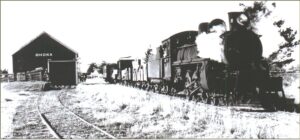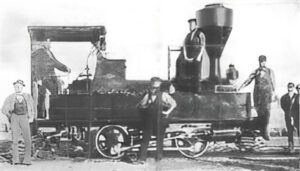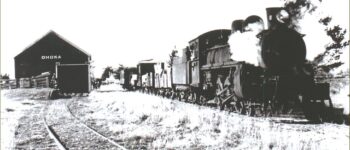1875: Eyreton Branch Line
December 27, 2022
By AHNZ
 Today in New Zealand history, 27 December, 1875, the Eyreton Branch railway line was opened.
Today in New Zealand history, 27 December, 1875, the Eyreton Branch railway line was opened.
New Zealanders outside Canterbury, and Otago as well, must have looked on at this latest government project in a fury. While they were crying out for railway infrastructure places like Canterbury were were abundant. There was a more or less parallel one line (Oxford Branch) only 10km north which had just opened in June of that same year.
This was a Vogel Government project defended by local Canterbury politicians at a time when the South Island ruled. It’s things like this that angered the rest of the people and led to support the abolition of provinces. Vogel’s Ministry, The Continuous Ministry, wanted to do away with provincial government entirely and had recently passed the legislation to do it. Ref. Abolition of Provinces Act (1875,) AHNZ
This branch line ran inland north of the Waimakariri River and two of the chief beneficiaries were John Evans Brown of Swannanoa and Isaac Wilson. Swannanoa received a railway ‘flag stop’ of which there is no trace today (I’ve looked¹.) Wilson got his own private railway siding (Wilson’s Siding) for direct freight to and from his flax/flour mill. Wilson was a very powerful businessman who also joined Brown as a Member of the House of Representatives. The image above appears to be the goods shed at Ohoka with the station obscured behind².
 The Eyreton Branch Railways opening was during the General Election of 1875 (20 December 1875 – 29 January 1876.) As such it probably treated the Northern Cantabrians to favor the sitting government. And, I assume, helped irritate non-Cantabrians into re-electing Vogel’s Gang and mandating the Abolition of Provinces policy.
The Eyreton Branch Railways opening was during the General Election of 1875 (20 December 1875 – 29 January 1876.) As such it probably treated the Northern Cantabrians to favor the sitting government. And, I assume, helped irritate non-Cantabrians into re-electing Vogel’s Gang and mandating the Abolition of Provinces policy.
The line never was profitable but considerations like that don’t matter when it’s a government project. Within months the Public Works Department announced a further join to the Oxford branch line, hoping to spread loss. This too was a financial failure according to Leitch and Scott (1995.) The line endured in some form until 1965.
Initially, the land it passed through was so swampy that the railway was nicknamed ‘The Ohoka Punt’. This could not have been a problem at the time as “Settler New Zealand” was dry or in flames right up to this time according to Rollo Arnold (1994.)
“That the two branches were only 10km apart is a reflection of the parochialism of the day when rival groups of settlers each wanted a railway line to serve and develop their own areas.” – p182 The Railways of New Zealand, Churchman and Hurst (1990)
“From its opening it failed to pay its way, its construction having been supported by local political interests competing with the services provided by the nearby Oxford branch.” – Milligan and Cuthbert (2015)
“Swannanoa was served by a flag-stop railway station (ie stops to let people off or if someone ‘flags’ the train down) on the old Eyreton Branch line, opened 27 December 1875. This train earned the name “Ohoka Punt” because the land it passed through was so swampy it resembled a boat! The opportunity to train to Swannanoa ended on 26 May 1954 and there’s nothing to mark the spot now on North Eyre Road. Back in 2002 Waimakariri District Council re-erected station nameboards along the ghost line but that left out Swannanoa (the image above is a poorly made fake one adapted from the one at Bennetts by AHNZ.)” – 1864: Swannanoa, AHNZ

It fills in some colour to know that my Eyreton ancestors had such an easy way to travel and shift goods.
On the other hand, this wasteful government spending by putting New Zealanders into debt harmed the economy badly. After the drug of ‘free’ money spending we were plunged into the hangover of The Long Depression.
Curious also to note that both the Oxford and Eyreton branch lines had a break of gauge with the South Island Main Trunk railway (reached Kaiapoi, 29 April 1872.) My conspiratorial speculation is that the political schemers behind the projects were cutting costs and probably cut a deal on some imported build-your-own-railway gear. Whatever money from the Vogel Miniboom cash lollyscramble they were allocated they could simply pocket after spending the minimal amount required on the big train set.
George Grey probably used the same idea in 1878 to buy obsolete artillery because of stoaked up public fear of Russian invasion. The only difference is that railway mania was based on desire and greed whereas arms buying is based on fear; Politicians are getting paid behind the scenes either way. The concrete facts are speculated but we do know that this is how Governments work. Labour 6.0 used its Covid-19 Response and Recovery Fund to fill the pockets of the program producers of Free School Lunches, Jobs for Nature, and Spy Cameras on Fishing Boats etc. Ref. 1878: Russian Scare, AHNZ. Ref. MacNamara (2022)
The New Zealand voter today is just as parochial for his own self-interests, just as easy to bribe, just as gullible, as he was in the 1870s.
—
1 The photo in this post of Swannanoa nameboards is a fake one by AHNZ created to match the other re-created ones from 2002.
2 See another picture of this scene in Knights Series, E.J. McClare Collection, p108 Graeme McClare, New Zealand Rail Trails, Mulligan and Cuthbert (2015)
Image ref. Ohoka station, unattributed photo. Ohoka Hall, Facebook (2017)
Image ref. Early engine on the Eyreton line. Sharpened up by AHNZ at the cost of making the men’s faces look like Autons
Image ref. Map tracing route of old line augmented by Wikipedia information, AHNZ 2015 based on now defunct website called vanderleer.info
Ref. Exploring NZ’s Ghost Railways, Leitch and Scott (1995)
Ref. Ref New Zealand’s Burning, R. Arnold (1994)
Ref. Budget 2022: How $2 billion of emergency Covid funds were redirected, Kate MacNamara, NZ Herald (2022)
 Like Comment Share
Like Comment Share





